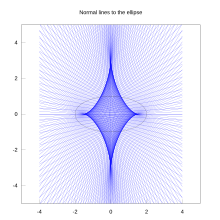
Back Astroïed Afrikaans Астроида Bulgarian Astroide Catalan Astroida Czech Astroide German Αστροειδής Greek Astroide Spanish Astroid Estonian Astroide Basque Astroidi Finnish





In mathematics, an astroid is a particular type of roulette curve: a hypocycloid with four cusps. Specifically, it is the locus of a point on a circle as it rolls inside a fixed circle with four times the radius.[1] By double generation, it is also the locus of a point on a circle as it rolls inside a fixed circle with 4/3 times the radius. It can also be defined as the envelope of a line segment of fixed length that moves while keeping an end point on each of the axes. It is therefore the envelope of the moving bar in the Trammel of Archimedes.
Its modern name comes from the Greek word for "star". It was proposed, originally in the form of "Astrois", by Joseph Johann von Littrow in 1838.[2][3] The curve had a variety of names, including tetracuspid (still used), cubocycloid, and paracycle. It is nearly identical in form to the evolute of an ellipse.
- ^ Yates
- ^ J. J. v. Littrow (1838). "§99. Die Astrois". Kurze Anleitung zur gesammten Mathematik. Wien. p. 299.
- ^ Loria, Gino (1902). Spezielle algebraische und transscendente ebene kurven. Theorie und Geschichte. Leipzig. pp. 224.
{{cite book}}: CS1 maint: location missing publisher (link)
© MMXXIII Rich X Search. We shall prevail. All rights reserved. Rich X Search